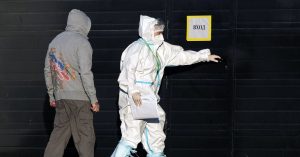
HOLLISTER, CA – DEC. 8: Dr. Michael Bogey oversees staff at Hazel Hawkins Memorial Hospital in Hollister, Calif., as people line up in cars for Covid tests and medical screenings at San Benito County’s only hospital, Tuesday, Dec. 8, 2020. (Karl Mondon/Bay Area News Group)
One day into a sweeping new shutdown, an explosion of new coronavirus cases and hospitalizations signaled California could be entering the darkest chapter yet of the state’s public health crisis with no quick end in sight.
Wielding a litany of alarming data points, state Health and Human Services Agency Secretary Mark Ghaly on Tuesday again implored Californians to stay home as much as possible. Whereas local health officials tied earlier outbreaks to certain higher-risk gatherings or workplaces, Ghaly said, the rampant spread of the virus throughout communities these days has ratcheted up the risk even from less-dangerous aspects of daily life.
“Activities that were lower-risk a month ago today are higher-risk,” he said. “It is so ubiquitous, so around our communities, that many activities are causing this transmission.”
Still, critics have questioned whether the latest restrictions are being targeted appropriately, since they allow some riskier indoor activities like shopping in stores and malls, while shutting down outdoor dining and playgrounds. Public health officials also acknowledged that after almost nine months of restrictions meant to contain the virus that have taxed their mental health and sent many businesses into a tailspin with little government help, Californians are growing increasingly restless at perhaps the most dangerous point of COVID-19’s grip on our lives.
“We are all battling pandemic fatigue,” Santa Clara County Health Officer Dr. Sara Cody said Tuesday. “Some are feeling a sense of complacency and a desire to get on with our lives, but this virus doesn’t care, and this virus wants to win.”
County health departments around California combined to report 34,136 new cases of COVID-19 on Monday, according to data compiled by this news organization, a staggering increase of more than 10,000 over the previous single-day record. The Bay Area also shattered its previous daily high with 4,380 new cases, including all-time records in San Francisco, Santa Clara, San Mateo and Contra Costa counties.
More than 10 percent of tests for coronavirus in California are now coming back positive, far outpacing the 3 percent positivity rate the state saw in early November.
Meanwhile number of patients being treated for coronavirus in hospitals and their intensive care units continues to rise. More than 11,500 people were hospitalized with the virus as of Monday, compared to fewer than 3,000 when the current surge began at the end of October; 2,526 of those patients were in ICUs, 3.5 times the number in those units in late October.
The surge of patients has been especially dramatic in Southern California, where just 10.1% of ICU beds were empty, and in the San Joaquin Valley, where capacity had dropped to 5.6%. Both regions have been placed under strict stay-home orders with their ICUs near capacity.
But all of California has seen significant increases — including the Bay Area, where 313 COVID patients were in ICUs across the 11-county region on Monday, almost four times as many as were there in late October. In Santa Clara County, the number of available ICU beds dropped from 50 to 31 just between Monday and Tuesday, health officials said, leaving just 9.5% capacity available. The county is discussing options with surrounding counties as well as the state for where it could send patients if its hospitals are overwhelmed.
And those hospitalization figures may not yet reflect the recent days’ surge of new cases or infections tied to travel over Thanksgiving, since it takes time for those who catch the virus to become seriously ill.
The state estimates that about 12% of new cases result in hospitalizations two to three weeks later, and 20-30% of hospitalizations eventually require an intensive care unit. By that estimate, the new cases confirmed on Monday alone could lead to an influx of more than 4,000 hospital patients and potentially another 1,000 ICU admissions in the coming weeks.
“We are certainly worried that with so many patients with COVID being admitted (and) a predictable number needing ICU care, that that system — that fragile but important system — may be overwhelmed,” Ghaly said. “And the goal of saving lives becomes threatened when that system isn’t as robust and as strong as it can be.”
As of Monday, 119 people had died from the virus each day on average over the past week, the highest that figure has reached since late August.
Even as hospitals work to add capacity and take on more patients, health officials are also warning that the state’s main shortage is not beds but hospital staff — the nurses and doctors needed to care for COVID patients, who are in demand throughout the state and country. Ghaly said California has a “tried and true” mutual aid system that allows regions to request staff from less hard-hit parts of the state. As the number of requests swell and more of the state and country grapples with surges, however, that system is being strained.
“We’re fulfilling what we can,” he said, “but it is getting harder.”
Staff writers Harriet Blair Rowan and Fiona Kelliher contributed reporting.


















